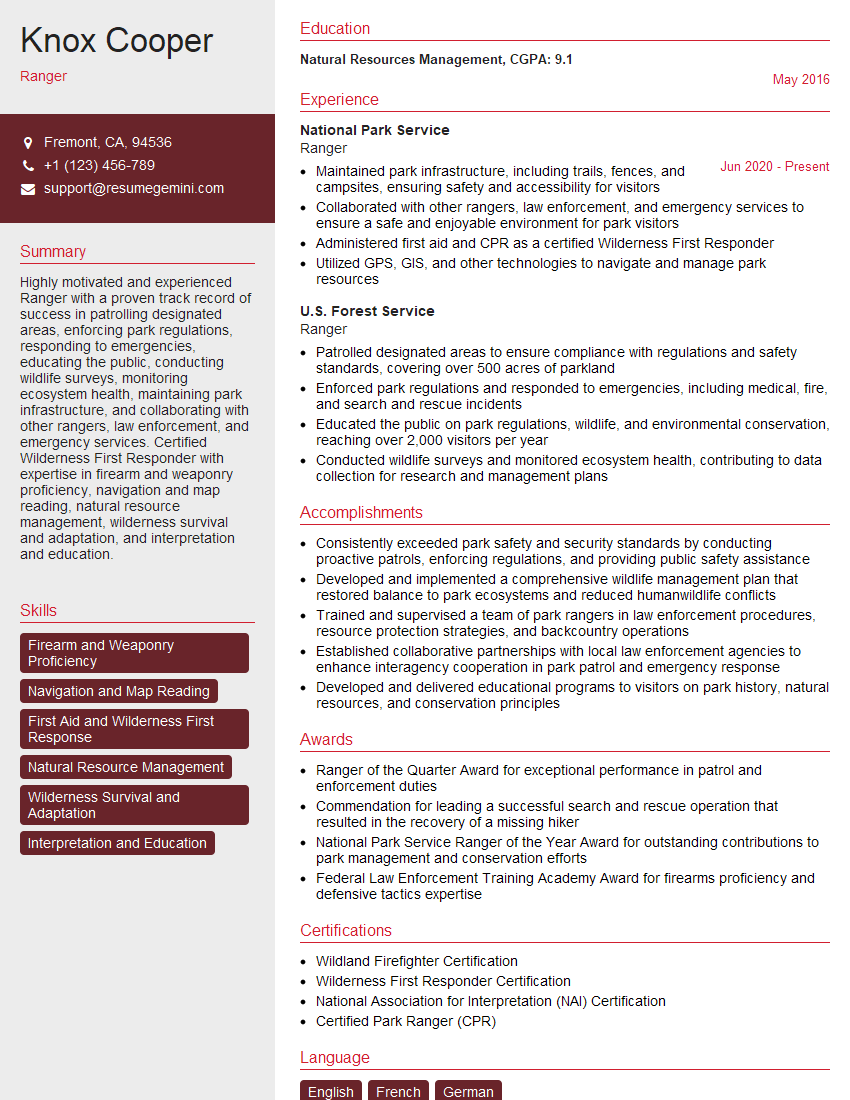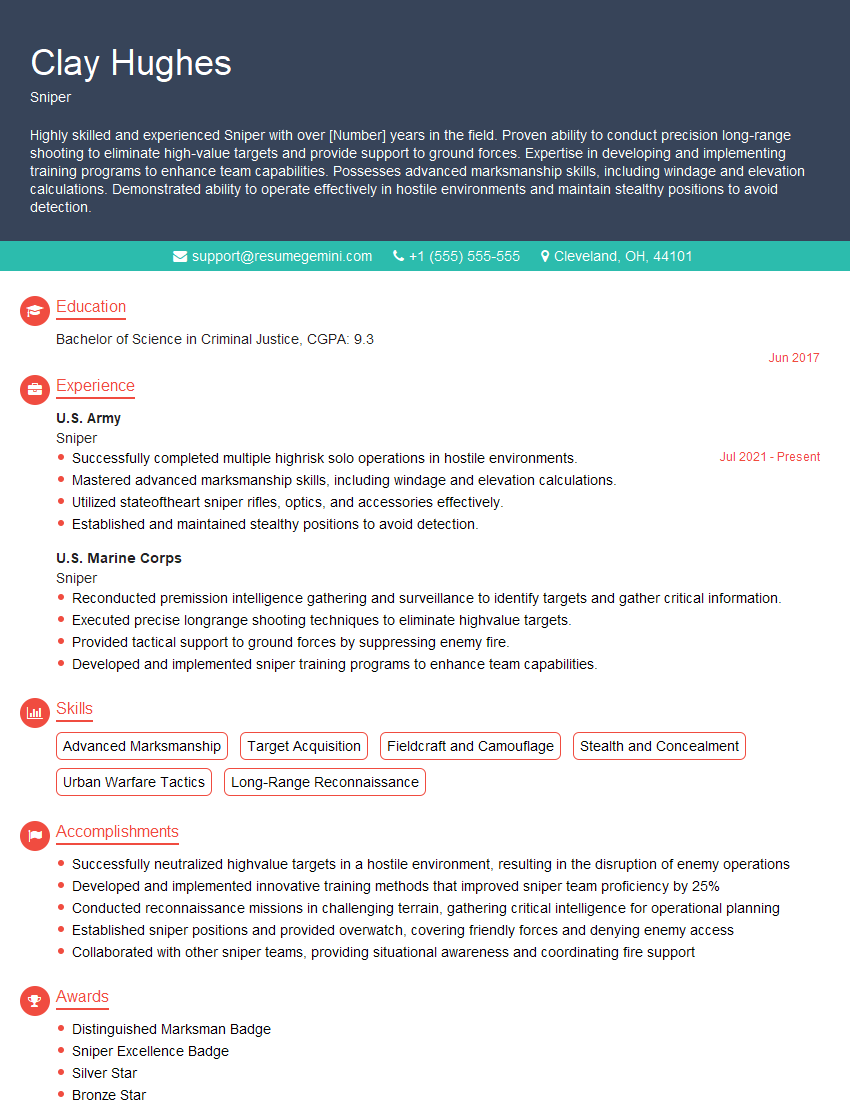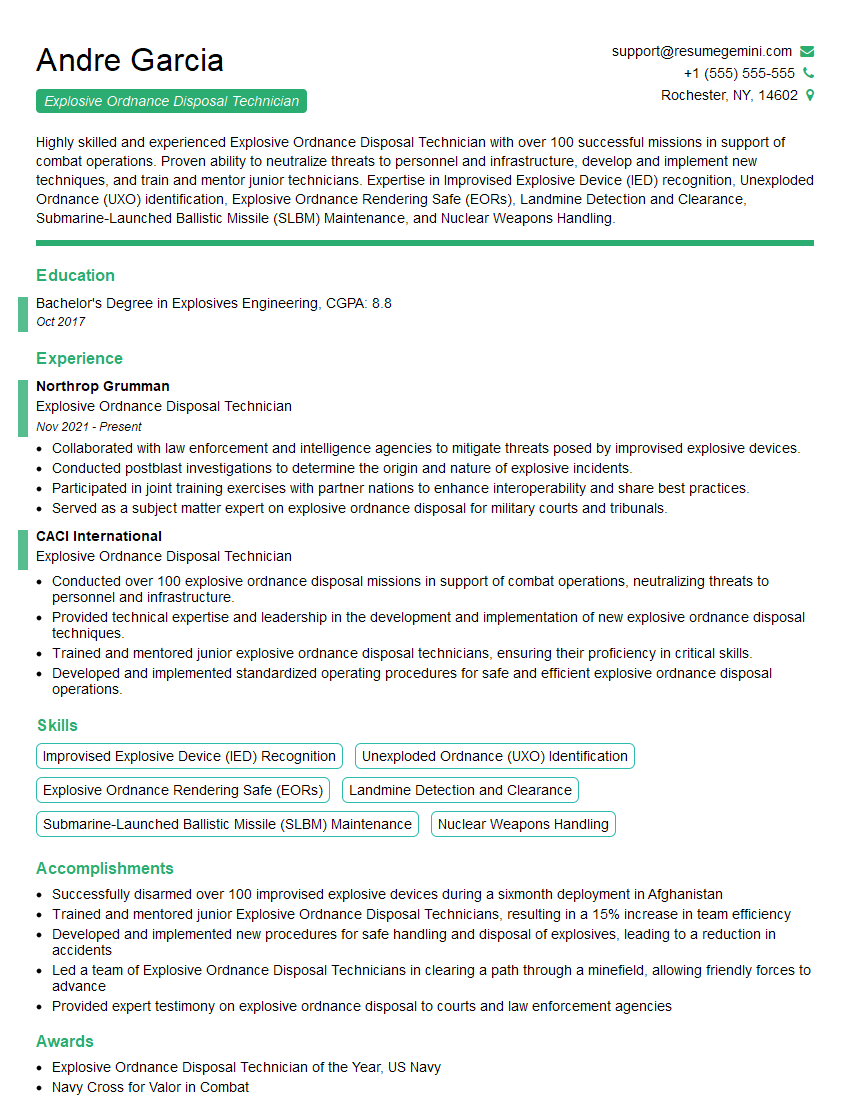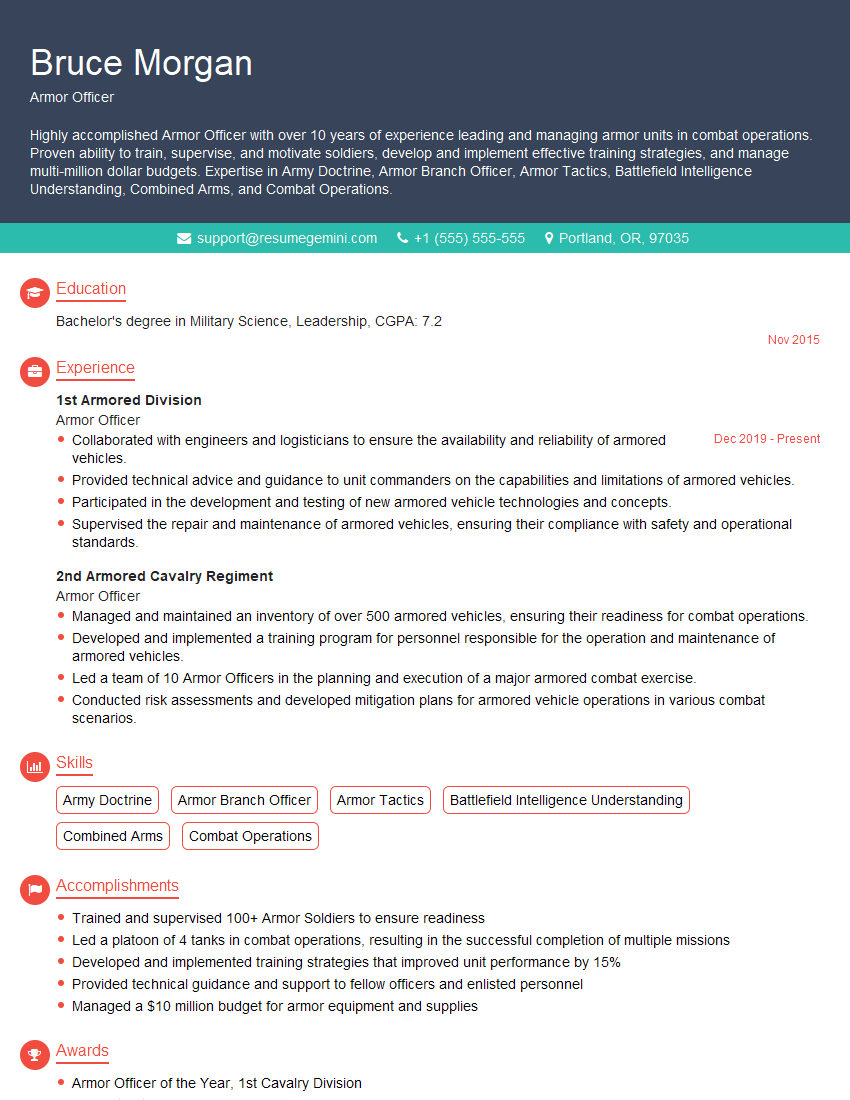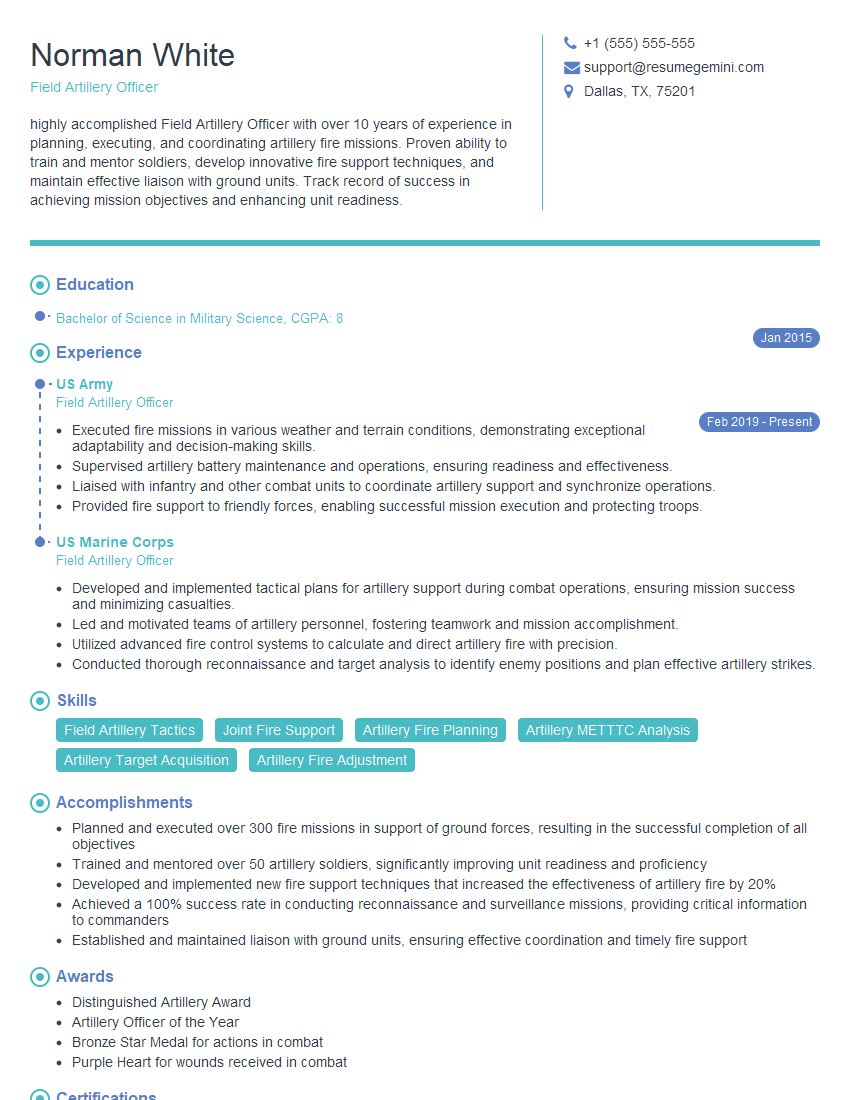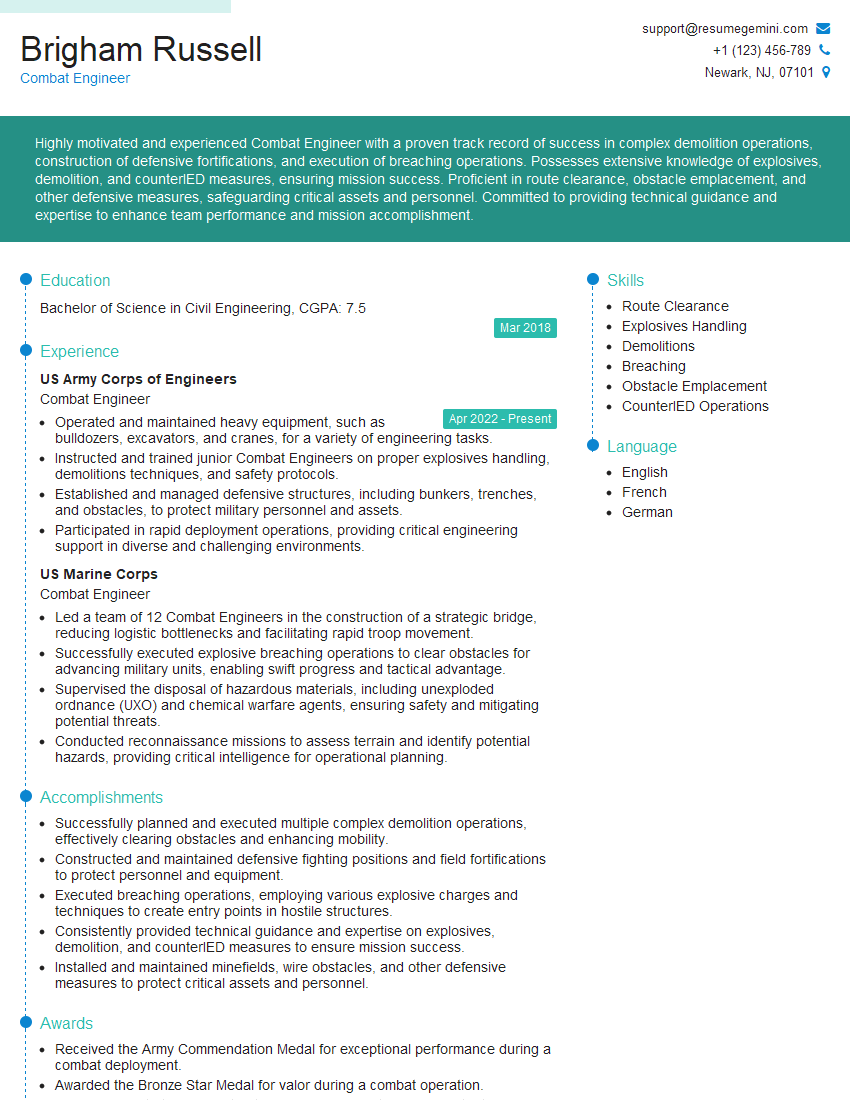The right preparation can turn an interview into an opportunity to showcase your expertise. This guide to Ground Combat Operations interview questions is your ultimate resource, providing key insights and tips to help you ace your responses and stand out as a top candidate.
Questions Asked in Ground Combat Operations Interview
Q 1. Describe your experience with land navigation techniques.
Land navigation is the ability to accurately determine one’s location on the ground and move to a specific point using a map, compass, and other tools. My experience encompasses years of training and field application, ranging from basic map reading and compass use to advanced techniques like resection and intersection. I’m proficient in using various map types, including topographic maps and digital terrain data. I’ve utilized GPS devices extensively, understanding their limitations and capabilities, particularly in challenging terrain or GPS-denied environments. For instance, during a field exercise in mountainous terrain, we were required to navigate to a designated point using only a map and compass after GPS malfunction. This involved using terrain association, identifying key features, and applying pacing techniques to ensure accurate movement.
My proficiency also extends to utilizing other aids like pace count, handrails (natural features to follow), and dead reckoning, understanding the importance of triangulation for pinpoint accuracy. I understand the impact of factors such as magnetic declination and terrain features on navigation accuracy and can compensate for them effectively. I’ve also trained extensively in celestial navigation techniques for situations where other means are unavailable.
Q 2. Explain the process of conducting a patrol.
Conducting a patrol involves a meticulous process that begins with thorough planning and ends with a comprehensive after-action review. The process typically involves these key steps:
- Planning: This includes defining the mission objective, identifying the route, considering potential threats, and assigning roles and responsibilities within the patrol. For example, a reconnaissance patrol might have a point man, a rear security element, and a compass man.
- Reconnoissance: Gathering information about the terrain and potential enemy presence before the patrol commences. This can involve aerial imagery analysis, and scouting.
- Movement: Utilizing appropriate movement techniques such as bounding overwatch or traveling formations, depending on the threat level. This ensures the team maintains security and is prepared for potential contacts. We’d carefully choose our routes to exploit terrain for cover and concealment.
- Observation and Reporting: Maintaining constant situational awareness, observing potential threats and recording relevant information. This information would be promptly reported up the chain of command.
- Actions on Contact: Responding appropriately to any enemy contact according to the established rules of engagement and the patrol’s specific orders.
- After-Action Review: Critically analyzing the patrol’s execution, identifying areas for improvement, and documenting lessons learned. This is vital for continuous improvement.
Q 3. Detail your proficiency in small unit tactics.
My proficiency in small unit tactics is grounded in years of training and practical application. I possess a deep understanding of fundamental tactical concepts like fire and maneuver, cover and concealment, and the use of terrain to gain a tactical advantage. I’m experienced in various formation movements, including wedge, file, and column formations, adapting them based on the terrain and threat level. I understand the importance of effective communication and coordination within the unit. I’ve led and participated in numerous exercises involving both offensive and defensive operations, practicing techniques such as breaching, clearing buildings, and conducting ambushes.
Furthermore, my training includes experience with close-quarters combat (CQC), utilizing various techniques for room clearing and close-range engagements. I am proficient in employing both lethal and non-lethal weaponry, and understand the critical importance of target identification and discrimination. For instance, during a military exercise simulating an urban environment, I effectively led a four-man element to secure a building while minimizing collateral damage.
Q 4. How would you react to a contact during a patrol?
My reaction to contact during a patrol would be swift, decisive, and based on established protocols. The immediate response would involve:
- React: Immediately returning fire and taking cover, prioritizing the protection of the patrol. This involves utilizing available terrain, and engaging targets effectively.
- Report: Immediately communicating the contact to higher headquarters, providing accurate location, enemy strength, and type of weapon. This ensures a timely response and coordinated action.
- Reorganize: Assessing the situation, reorganizing the patrol into a more effective formation for engagement or withdrawal.
- Request: If necessary, requesting reinforcements or medical evacuation (MEDEVAC).
- Assess: After neutralizing the threat, assessing casualties and securing the area. This might include searching the area, collecting intelligence, and securing any captured weapons.
The specific actions would be dictated by the situation, enemy capabilities, the availability of support, and the patrol’s mission. For example, if the contact is a fleeting observation, the response may involve simply maintaining vigilance and continuing the patrol; whereas a direct engagement requires immediate and decisive action.
Q 5. What are your strategies for maintaining situational awareness?
Maintaining situational awareness (SA) is paramount in ground combat operations. My strategies encompass a multi-faceted approach, incorporating the following:
- 360-degree awareness: Constantly scanning the surroundings, utilizing all senses to detect potential threats. This includes paying close attention to visual cues, sounds, and even smells.
- Communication: Maintaining constant communication with the patrol members, sharing observations and alerting each other to any potential threats.
- Use of terrain: Utilizing terrain to gain a tactical advantage, seeking cover and concealment while maintaining observation. I constantly look for opportunities to improve our tactical position.
- Intelligence gathering: Using all available intelligence sources to predict potential threats and adjust the patrol’s actions accordingly.
- Risk assessment: Continuously assessing the potential risks and adjusting the patrol’s tactics to mitigate those risks.
For example, in a dense jungle environment, I would utilize additional senses (sound, smell) more diligently than in an open desert, to anticipate ambushes or potential threats hidden by vegetation.
Q 6. Outline your experience with combat first aid.
My combat first aid training is extensive, encompassing both basic and advanced life support techniques. I am certified in advanced trauma life support (ATLS) and have practical experience in treating a wide range of injuries, including gunshot wounds, blast injuries, and fractures. My skills include:
- Trauma assessment: Quickly assessing the severity of injuries and prioritizing treatment based on the patient’s condition.
- Wound management: Controlling bleeding, dressing wounds, and preventing infection.
- Fracture management: Stabilizing fractures, splinting limbs, and preventing further injury.
- Airway management: Clearing and maintaining a patient’s airway.
- IV insertion: Inserting intravenous lines for fluid resuscitation.
- Emergency medical evacuation (MEDEVAC) coordination: Coordinating the evacuation of casualties to higher levels of medical care.
I’ve participated in numerous medical training exercises and real-world scenarios where I’ve applied these skills to save lives. This includes providing immediate care under stressful conditions, and working effectively under pressure.
Q 7. Explain your understanding of rules of engagement.
Rules of Engagement (ROE) are the directives that dictate the circumstances and conditions under which military force may be used. My understanding of ROE is comprehensive and mission-specific. They are crucial for maintaining legal and ethical standards during operations. I understand that ROE vary depending on the mission, the geographical location, and the specific threats faced. I know how to interpret the ROE, and apply them in complex and dynamic situations, balancing the need to protect my unit and civilian populations while upholding the law of war. Improper ROE can lead to unintended consequences and serious legal repercussions.
For example, the distinction between hostile and non-hostile actors is critical. I have a thorough understanding of the criteria used to identify hostiles, avoiding unintended escalation and collateral damage. I understand that there are specific ROE on using lethal and non-lethal force, and can make informed decisions based on immediate circumstances and potential threat levels.
Q 8. Describe your experience with weapons systems and maintenance.
My experience with weapons systems encompasses a wide range, from the M4 Carbine and M249 Squad Automatic Weapon to heavier systems like the Javelin anti-tank missile. I’m proficient in their operation, maintenance, and troubleshooting. Maintenance isn’t just about cleaning and lubricating; it’s about preventative measures, ensuring weapons are reliable under duress. For example, I’ve led teams in conducting thorough preventative maintenance checks (PMCs) before and after every mission, catching potential issues before they become critical failures in combat. This includes identifying and rectifying malfunctions, performing bore sighting, and ensuring proper functioning of all ancillary systems like optics and laser sights. We use a standardized checklist to ensure comprehensive coverage, much like a pilot uses a pre-flight checklist. This rigorous approach is essential to ensure mission success and the safety of the team.
I also have experience with the logistical side, ensuring we have the appropriate ammunition and spare parts. In one instance, during a prolonged operation, we anticipated a potential shortage of specific ammunition. I proactively coordinated with supply to ensure a timely resupply, averting a critical shortfall that could have compromised our mission. This highlights the importance of anticipating supply needs and communicating effectively with support personnel.
Q 9. How do you plan and execute a fire and maneuver operation?
Fire and maneuver is a fundamental tactic in ground combat, balancing offensive firepower with tactical movement. It’s about coordinated action, not just shooting and running. Planning involves careful consideration of the enemy’s position, strength, and likely reactions. We use intelligence gathering, reconnaissance, and terrain analysis to build a detailed picture of the battlefield. This picture forms the foundation of our plan.
Execution begins with a detailed brief to the team. We’ll cover the objectives, routes, timings, fire support plans (including coordinating with artillery or air support if available), communication protocols, and contingency plans (what to do if things go wrong). We always emphasize communication and mutual support. Think of it like a well-orchestrated symphony: each element plays its part in perfect harmony to achieve the overall objective.
During execution, the fire element (often heavier weapons or designated marksmen) suppresses the enemy while the maneuver element advances, exploiting any gaps or weaknesses. Continuous communication is crucial, providing real-time updates on the enemy’s position and any changes to the plan. For example, if we encounter unexpected enemy resistance, the maneuver element may shift its approach, while the fire element adjusts its support accordingly. The whole operation is a dynamic process, constantly adapting to the changing situation on the ground. After action reviews are critical to identify what went well and where improvements can be made. This is a continuous learning process.
Q 10. What is your approach to risk assessment in combat situations?
Risk assessment in combat is a continuous process, not a one-time event. It involves identifying potential hazards, analyzing their likelihood and severity, and developing mitigation strategies. We use a structured approach, considering factors such as the enemy’s capabilities, the terrain, the weather, and the availability of resources.
For example, before any operation, we’ll conduct a thorough risk assessment, identifying potential dangers like enemy ambushes, IEDs, or adverse weather conditions. We then assign risk levels (high, medium, low) to each hazard. Based on this assessment, we develop mitigation strategies. This might include adjusting routes, increasing security measures (like patrols), or deploying additional fire support. Risk assessment is not about eliminating all risk; it’s about managing it to an acceptable level, always balancing risk against mission objectives. Sometimes, the mission demands accepting a higher level of risk. The key is informed decision-making based on a thorough and accurate assessment.
Q 11. Explain your understanding of different types of terrain and their impact on operations.
Understanding terrain is fundamental to successful operations. Different terrains present unique challenges and opportunities. Open terrain offers good visibility but little cover, making it advantageous for the side with superior firepower. Conversely, built-up areas, dense forests, or mountainous regions offer ample cover and concealment but can restrict maneuverability.
Urban environments present unique challenges, requiring specialized techniques for navigating narrow streets and buildings. Mountainous terrain necessitates careful planning to account for elevation changes, limited visibility, and potential for landslides or rockfalls. Jungle warfare poses its own set of difficulties, such as navigating dense vegetation and dealing with high humidity and diseases. Each environment necessitates specialized tactics, equipment, and training. For instance, in urban areas, we utilize breaching techniques and close-quarters battle (CQB) drills. In mountainous regions, we focus on route planning, avoiding exposure, and ensuring secure communication. Adaptability is key to operating successfully across diverse terrains.
Q 12. Describe your experience with close-quarters combat (CQB).
Close-quarters combat (CQB) is inherently dangerous, demanding precision, teamwork, and decisive action. My CQB training emphasizes controlled movements, coordinated fire, and effective communication. We practice clearing rooms systematically, using techniques like stacking and slicing to cover each other’s blind spots. Situational awareness is paramount.
I’ve participated in numerous CQB training exercises, simulating various scenarios, from clearing buildings to responding to hostage situations. These exercises have honed my skills in weapon handling, room clearing techniques, and tactical communication in confined spaces. We emphasize speed and precision in our movements, ensuring that we minimize our exposure to enemy fire while maximizing our offensive capabilities. For example, effective use of flashbang grenades disrupts the enemy’s vision and coordination, providing a vital advantage in a close quarters fight. Successful CQB relies heavily on meticulous planning and precise execution, and constant training to maintain proficiency.
Q 13. How do you manage stress and maintain composure under pressure?
Managing stress in combat is crucial for survival and mission success. My approach is multifaceted, drawing on physical and mental strategies. Physically, maintaining peak fitness, proper nutrition, and sufficient sleep are essential. Mentally, I utilize techniques such as controlled breathing, mindfulness, and mental rehearsal to manage anxiety.
I also prioritize a strong support network, both within my unit and outside. Open communication with my team and family allows me to share my experiences and seek support when needed. In high-pressure situations, I focus on the immediate task at hand, breaking down complex problems into smaller, manageable steps. This prevents mental overload and allows me to maintain focus and composure even under extreme pressure. Maintaining a strong sense of self-discipline and confidence, cultivated through rigorous training and preparation, is also essential. The ability to stay calm and think clearly under pressure is something I’ve deliberately cultivated.
Q 14. What are your leadership strategies in a combat environment?
Leadership in a combat environment demands decisiveness, empathy, and unwavering commitment to the team’s well-being and mission success. My leadership style is built on trust, mutual respect, and clear communication. I lead by example, demonstrating courage, professionalism, and a commitment to the highest standards.
I empower my team members, delegating tasks based on their strengths and providing them with the authority and resources to execute their roles effectively. I foster a culture of open communication, ensuring everyone feels comfortable voicing their concerns and sharing their ideas. This approach is essential for maintaining team cohesion and morale in a stressful environment. Regular training and mentorship are also critical, not just for enhancing skills but also for building confidence and trust among team members. Ultimately, effective leadership in combat boils down to ensuring that everyone is properly trained, well-equipped, and feels confident in their ability to succeed.
Q 15. Describe a time you had to make a difficult decision under pressure.
During a patrol in a volatile region, we encountered unexpected enemy fire. We were pinned down, and I had to quickly decide whether to attempt a hasty withdrawal, potentially leaving a wounded comrade behind, or to hold our position and risk further casualties. This decision weighed heavily on me, as both options presented significant risks. After assessing the situation – the severity of the injuries, the enemy’s position and strength, and the terrain – I chose to establish a defensive perimeter, requesting immediate medical evacuation while providing covering fire. The evacuation was successful, and we minimized further losses. This situation highlighted the critical importance of rapid risk assessment, decisive action under pressure, and prioritizing the safety of the team.
The key to making difficult decisions under pressure isn’t about eliminating risk, it’s about calculating and managing it effectively. A systematic approach involving rapid assessment, clear communication, and timely execution is crucial. This experience cemented the need for thorough planning and contingency preparation, as well as trusting the instincts developed through rigorous training and real-world experience.
Career Expert Tips:
- Ace those interviews! Prepare effectively by reviewing the Top 50 Most Common Interview Questions on ResumeGemini.
- Navigate your job search with confidence! Explore a wide range of Career Tips on ResumeGemini. Learn about common challenges and recommendations to overcome them.
- Craft the perfect resume! Master the Art of Resume Writing with ResumeGemini’s guide. Showcase your unique qualifications and achievements effectively.
- Don’t miss out on holiday savings! Build your dream resume with ResumeGemini’s ATS optimized templates.
Q 16. Explain your experience with communication systems and procedures.
My experience encompasses a wide range of communication systems, from basic hand signals and radio procedures to more advanced satellite communication systems. I am proficient in utilizing various radio frequencies and encryption methods, adhering to strict communication protocols to maintain operational security. Understanding the limitations of each system is vital; for example, using hand signals is efficient in close proximity, but unreliable in dense terrain or at long distances, where radios are preferred. However, radio communication can be easily intercepted, so careful message composition is crucial.
In practice, I’ve overseen the implementation and maintenance of communication nets in challenging environments. This includes ensuring all team members are properly trained in their use, regularly conducting communication drills, and troubleshooting equipment malfunctions in the field. Effective communication is the backbone of successful ground combat operations – it dictates the flow of information, coordinates maneuvers, and ensures the safety and efficiency of the mission.
Q 17. How do you ensure the safety and well-being of your team members?
Ensuring team member safety and well-being is paramount. It starts with comprehensive risk assessment before any operation. This involves analyzing the mission’s potential hazards, from enemy contact to environmental factors, and developing mitigation strategies accordingly. Before each mission, we conduct thorough briefings, detailing the plan, potential threats, and emergency procedures. I emphasize strict adherence to safety regulations, proper use of equipment, and buddy systems. We continually reinforce the importance of situational awareness, proactive risk avoidance and self-preservation.
Beyond mission planning, it’s critical to foster a strong team dynamic built on mutual respect and trust. Open communication channels encourage soldiers to report concerns and avoid taking unnecessary risks. Regular check-ins, particularly during periods of high stress, are vital for monitoring the mental and physical health of the team. Recognizing and addressing signs of fatigue, stress, or injury are just as important as the tactical aspects of operations. Essentially, proactive safety measures are about more than following rules; they are about creating a culture of safety and responsibility.
Q 18. How would you handle a casualty in a combat zone?
Handling a casualty in a combat zone requires immediate, coordinated action. The first step is to prioritize the casualty’s immediate survival, securing the area to avoid further injury. We implement the tactical combat casualty care (TCCC) guidelines: I would immediately assess the casualty’s condition, controlling bleeding, managing airway and breathing, and treating shock. If necessary, this includes improvising medical equipment from available resources.
Simultaneously, I would radio for medical evacuation, providing precise location coordinates and the casualty’s condition. The team would establish a defensive perimeter, protecting both the casualty and the medical evacuation team. Once the casualty is stabilized, they would be carefully moved to a secure location for further treatment and evacuation. Efficient communication, quick thinking, and the ability to apply TCCC under duress are essential to minimize loss of life.
Q 19. Describe your experience with urban warfare.
Urban warfare presents unique challenges, demanding adaptability and precision. Unlike open terrain, urban environments offer limited visibility, increased risk of fratricide, and numerous potential hiding places for the enemy. My experience includes navigating complex urban layouts, clearing buildings systematically (using methods like ‘room-clearing’ techniques), and employing close-quarters combat tactics. Clear communication is amplified, using hand signals and discrete radio communication due to the potential for enemy eavesdropping.
Understanding the urban landscape – building structures, chokepoints, and lines of sight – is crucial. We would utilize flanking maneuvers, suppress enemy positions from multiple angles, and leverage urban cover and concealment to our advantage. Improvised explosive devices (IEDs) pose a significant threat in urban environments. Therefore, careful route planning, thorough reconnaissance, and specialized training to detect and disarm IEDs are paramount.
Q 20. Explain your understanding of military intelligence and its role in combat operations.
Military intelligence plays a pivotal role, providing crucial information for effective planning and execution of combat operations. It involves the collection, analysis, and dissemination of intelligence regarding the enemy, terrain, and local population. This includes human intelligence (HUMINT), signals intelligence (SIGINT), imagery intelligence (IMINT), and more. For example, HUMINT, gathered from local informants, can provide insights into enemy movements, strengths, and weaknesses; SIGINT intercepts enemy communications; and IMINT provides aerial views for planning and reconnaissance.
Accurate and timely intelligence allows commanders to anticipate enemy actions, tailor strategies, and minimize risks. In practice, we rely heavily on intelligence assessments to choose routes, determine deployment locations, and identify potential threats. Analyzing intelligence products helps to understand the enemy’s capabilities, tactics, and intentions, enabling us to formulate superior combat strategies and ultimately, achieve our objectives while minimizing casualties.
Q 21. How do you adapt your tactics to different enemy forces?
Adaptability is key when confronting diverse enemy forces. We approach each enemy differently, tailoring our tactics to their specific strengths and weaknesses. For instance, a technologically advanced enemy would require us to adopt defensive and evasive tactics, potentially emphasizing electronic warfare and asymmetric warfare. In contrast, when facing a less technologically advanced but numerically superior enemy, tactics might focus on utilizing superior firepower, mobility, and air support to offset their numerical advantage.
Before engaging any enemy, thorough intelligence gathering helps in understanding their doctrine, equipment, and fighting style. This intelligence drives the adaptation of tactics, ranging from weapon systems and fire support to maneuver techniques. Continuous monitoring and adjustment of the tactical approach are crucial for success in combat, emphasizing flexibility and the ability to react to changing circumstances and enemy responses during operations.
Q 22. What is your experience with reconnaissance and surveillance operations?
Reconnaissance and surveillance (R&S) operations are the eyes and ears of any ground combat operation, providing critical intelligence to inform decision-making. My experience encompasses planning and executing various R&S missions, from small-scale patrols utilizing basic observation techniques to large-scale operations incorporating advanced technology like UAVs and sophisticated sensor systems. I’ve personally led and participated in missions involving both human intelligence (HUMINT) gathering through local interaction and signal intelligence (SIGINT) analysis to pinpoint enemy positions and activities. For example, during Operation Desert Shield, I was part of a team tasked with identifying potential enemy emplacements before a major offensive. We employed a combination of aerial reconnaissance and ground patrols, meticulously documenting our findings and feeding that intelligence to higher command, ultimately contributing to a successful operation with minimal friendly casualties.
My expertise includes selecting appropriate methods based on the operational environment, risk assessment, and available resources. This includes understanding the limitations and capabilities of different technologies and adapting techniques to overcome challenges, like poor visibility or dense terrain. Effective R&S isn’t just about gathering data; it’s about analyzing it, interpreting it accurately, and delivering timely, actionable intelligence to commanders.
Q 23. Describe your experience with coordinating with supporting arms.
Coordinating with supporting arms – artillery, close air support (CAS), mortars, and engineers – is paramount to successful ground combat operations. My experience involves detailed planning and execution, emphasizing clear communication, precise targeting, and constant coordination throughout the operation. I’ve learned the importance of establishing a common operational picture (COP) to ensure everyone understands the situation, objectives, and the capabilities and limitations of each supporting arm.
A key aspect is developing and maintaining a robust communication network. This could involve using radio frequencies, dedicated communication channels, or even physical messengers in challenging environments. Effective communication isn’t just about transmitting data; it’s about confirming receipt and understanding, anticipating potential problems, and adapting to changing circumstances. For instance, during a complex urban assault, I successfully coordinated CAS strikes to neutralize enemy strong points, ensuring civilian casualties were minimized through meticulous target selection and real-time communication with the aircrew. The success of such coordinated efforts relies heavily on trust, clear protocols, and meticulous planning.
Q 24. How do you maintain discipline and morale in a combat unit?
Maintaining discipline and morale in a combat unit is crucial for mission success and the well-being of the soldiers. My approach is multifaceted and focuses on leading by example, fostering a strong sense of camaraderie, and ensuring fair and consistent application of rules and regulations. I believe in open communication, actively seeking feedback from my soldiers and addressing their concerns promptly. Recognizing and rewarding good performance boosts morale, while addressing misconduct fairly and consistently helps maintain discipline.
Building trust and mutual respect is essential. Soldiers need to know that their leaders care about their well-being and are committed to their success. Providing opportunities for professional development, recognizing individual strengths, and fostering a team-oriented environment are key components. Furthermore, ensuring adequate rest, food, and medical care contributes significantly to maintaining high morale. It’s about creating an environment where soldiers feel valued, respected, and confident in their ability to accomplish the mission, even under immense pressure. During my time in command, we consistently exceeded expectations despite facing challenging conditions; this was directly attributed to the high morale and discipline within the unit.
Q 25. What is your understanding of the legal and ethical considerations in combat?
A deep understanding of the legal and ethical considerations in combat is crucial for maintaining the moral high ground and avoiding unnecessary harm. This includes strict adherence to the Laws of Armed Conflict (LOAC), the rules of engagement (ROE), and the principles of proportionality and distinction.
LOAC dictates how we conduct warfare, protecting civilians, prisoners of war, and wounded combatants. ROE outlines the specific circumstances under which force can be used. Proportionality ensures that the military response is appropriate to the threat, while distinction requires us to discriminate between combatants and non-combatants. I’ve always stressed the importance of ethical decision-making and emphasized the consequences of violating these principles. Prioritizing the safety of non-combatants and adhering to international humanitarian law is not just a legal obligation; it’s a moral imperative that reflects on the character of our forces and the values of our nation. We train regularly on these principles, and ethical dilemmas are discussed openly and thoroughly within the unit.
Q 26. How do you plan for and execute a breach operation?
A breach operation, the forceful entry into a fortified position, requires meticulous planning and precise execution. It begins with thorough intelligence gathering to understand the target’s defenses, including the layout, strength, and likely reactions. The plan must outline the breach method (explosives, breaching tools, or a combination), the assault force’s composition, supporting arms, and communication protocols.
The execution involves a coordinated assault, with teams specializing in breaching, clearing, and securing. Suppressive fire is crucial to create openings for the breaching team. Once the breach is established, the assault force rapidly clears the objective, neutralizing any resistance. Post-breach security is paramount, establishing a secure perimeter to prevent enemy counterattacks. Each stage requires close coordination, effective communication, and rapid adaptation to unforeseen circumstances. For example, during a training exercise simulating a breach of a heavily fortified building, we employed a phased approach with explosives to create entry points, followed by a coordinated assault by specialized teams. The exercise successfully demonstrated the effectiveness of our training and the importance of clear communication under pressure.
Q 27. Describe your experience with utilizing cover and concealment.
Utilizing cover and concealment is fundamental to survival in combat. Cover protects from enemy fire, while concealment hides you from enemy observation. Cover is anything that provides physical protection, such as a wall, a vehicle, or a large rock. Concealment hides you from view, such as tall grass, shadows, or camouflage.
My experience involves teaching soldiers how to effectively use both, emphasizing situational awareness and understanding the enemy’s perspective. We train soldiers to identify and utilize available cover and concealment instinctively, adapting to the environment and the type of threat. This includes understanding how to use natural terrain, urban structures, and man-made obstacles to their advantage. Effective use of cover and concealment dramatically increases survivability and reduces the risk of casualties. It’s not just about finding a place to hide; it’s about using the environment intelligently to maximize your advantage and minimize your exposure to enemy fire.
Q 28. Explain your understanding of the military decision-making process (MDMP).
The Military Decision-Making Process (MDMP) is a systematic and iterative approach to planning military operations. It involves a series of steps, ensuring a thorough assessment of the situation, the development of a feasible plan, and the subsequent execution and assessment.
- Receipt of Mission: Understanding the higher command’s order and intent.
- Mission Analysis: Analyzing the mission, the enemy, terrain, troops, time available, and civil considerations (METT-TC).
- Course of Action (COA) Development: Brainstorming and developing potential solutions.
- COA Analysis (Wargaming): Evaluating each COA’s strengths and weaknesses.
- COA Comparison: Comparing COAs and selecting the best option.
- Orders Development: Creating and disseminating the operational orders.
- Supervision: Monitoring and adapting the plan as needed during execution.
I have extensive experience using MDMP in various operational settings, from small-unit tactical operations to larger-scale campaign planning. It provides a structured framework for decision-making, ensuring all aspects of an operation are considered and that the plan is robust and adaptable. The iterative nature allows for adjustments based on new intelligence or changing circumstances. Successful application of MDMP leads to well-coordinated operations, reduced risks, and increased chances of success.
Key Topics to Learn for Ground Combat Operations Interview
- Tactical Planning & Execution: Understanding mission planning, risk assessment, and the execution of complex operations in diverse terrains.
- Combat Maneuvers & Fire Support: Practical application of infantry tactics, coordination with supporting arms (artillery, air support), and effective use of cover and concealment.
- Leadership & Command: Demonstrating understanding of leadership principles in high-stress environments, decision-making under pressure, and effective communication within a team.
- Logistics & Supply Chain Management: Knowledge of the importance of resource management, supply chain optimization, and maintaining operational readiness in challenging conditions.
- Intelligence Gathering & Analysis: Understanding the importance of intelligence in planning and execution, methods of information gathering, and threat assessment.
- Communication & Coordination: Mastering various communication methods (radio, hand signals) and effective coordination with allied units and civilian populations.
- Weapons Systems & Equipment: Familiarity with common ground combat weapons, equipment maintenance, and safety procedures.
- Survival & Evasion Techniques: Understanding basic survival skills, first aid, and evasion tactics in hostile territories.
- Ethical Considerations & Rules of Engagement: Demonstrating a clear understanding of the ethical implications of combat operations and adherence to the rules of engagement.
- Problem-Solving & Critical Thinking: Highlighting your ability to assess situations rapidly, make sound judgments, and adapt to unforeseen circumstances.
Next Steps
Mastering Ground Combat Operations is crucial for career advancement, opening doors to leadership roles and specialized assignments. A strong, ATS-friendly resume is essential to showcase your skills and experience effectively to potential employers. To help you build a compelling resume that highlights your expertise in Ground Combat Operations, we recommend using ResumeGemini. ResumeGemini provides a user-friendly platform to create professional resumes and offers examples tailored specifically to Ground Combat Operations, ensuring your application stands out.
Explore more articles
Users Rating of Our Blogs
Share Your Experience
We value your feedback! Please rate our content and share your thoughts (optional).
What Readers Say About Our Blog
Hello,
We found issues with your domain’s email setup that may be sending your messages to spam or blocking them completely. InboxShield Mini shows you how to fix it in minutes — no tech skills required.
Scan your domain now for details: https://inboxshield-mini.com/
— Adam @ InboxShield Mini
Reply STOP to unsubscribe
Hi, are you owner of interviewgemini.com? What if I told you I could help you find extra time in your schedule, reconnect with leads you didn’t even realize you missed, and bring in more “I want to work with you” conversations, without increasing your ad spend or hiring a full-time employee?
All with a flexible, budget-friendly service that could easily pay for itself. Sounds good?
Would it be nice to jump on a quick 10-minute call so I can show you exactly how we make this work?
Best,
Hapei
Marketing Director
Hey, I know you’re the owner of interviewgemini.com. I’ll be quick.
Fundraising for your business is tough and time-consuming. We make it easier by guaranteeing two private investor meetings each month, for six months. No demos, no pitch events – just direct introductions to active investors matched to your startup.
If youR17;re raising, this could help you build real momentum. Want me to send more info?
Hi, I represent an SEO company that specialises in getting you AI citations and higher rankings on Google. I’d like to offer you a 100% free SEO audit for your website. Would you be interested?
Hi, I represent an SEO company that specialises in getting you AI citations and higher rankings on Google. I’d like to offer you a 100% free SEO audit for your website. Would you be interested?
good
